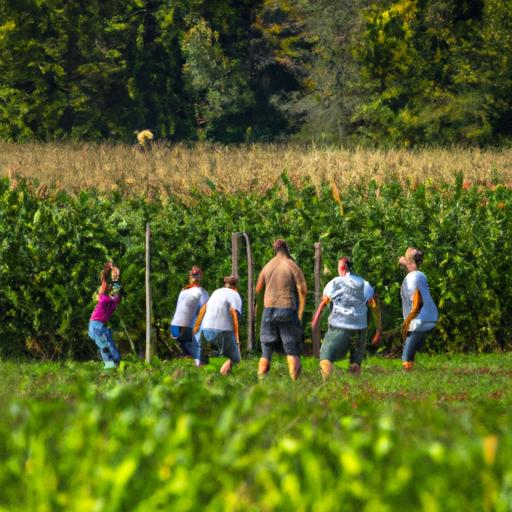In the bustling world of agriculture, where hard work and dedication are the norm, have you ever wondered if there’s room for leisure? Well, the answer lies in the concept of recreation in agriculture. But what exactly does this term entail? In this article, we’ll explore the definition of recreation in agriculture and delve into its significance for farmers and the agricultural community as a whole.
A. Definition of Recreation in Agriculture
Recreation in agriculture refers to the intentional incorporation of leisure activities within the farming environment. It encompasses a wide range of pursuits that aim to offer farmers and agricultural enthusiasts a much-needed respite from their demanding routines. Think of it as a way to find a balance between toil and rejuvenation, where farming coexists harmoniously with recreational experiences.
B. Importance of Recreation in Agriculture
Now, you might be wondering, why should recreation be a priority in agriculture? The answer lies in the numerous benefits it brings to both farmers and the agricultural industry. Recreation serves as a vital tool in combating the stress and pressures associated with farming. It acts as a therapeutic outlet, nurturing the mental well-being of those who toil tirelessly to feed the world.
Furthermore, engaging in recreational activities within the agricultural setting has proven to enhance productivity and job satisfaction. When farmers take time to unwind and indulge in leisure pursuits, they return to their work with renewed energy and enthusiasm. This not only improves their overall performance but also fosters a sense of fulfillment in their chosen profession.
C. Overview of the Article
Throughout this article, we will explore the significance of recreation in agriculture by delving into its various benefits, types, and examples. We will uncover how recreational activities contribute to stress relief, improved mental health, and increased productivity for farmers. Additionally, we will examine the different types of recreation in agriculture, ranging from outdoor activities like farm tours and nature walks to indoor experiences like farm-themed games and educational workshops.
So, join me as we embark on a journey to unravel the world of recreation in agriculture. Together, we will discover how leisure and farming intertwine, nurturing not only the land but also the souls of those who tend to it.
Benefits of Recreation in Agriculture
Farming is undoubtedly a demanding occupation that requires unwavering dedication and hard work. However, integrating recreation into the agricultural lifestyle brings forth a multitude of advantages. Let’s explore how recreation in agriculture positively impacts farmers and the agricultural community as a whole.
A. Stress Relief for Farmers
Farming can be a highly stressful endeavor, with unpredictable weather, financial pressures, and long hours of labor. Engaging in recreational activities offers farmers a much-needed escape from these stressors. Whether it’s taking a leisurely stroll through the fields or indulging in a hobby like fishing, these moments of respite provide a sense of tranquility and relief. By allowing their minds and bodies to relax, farmers can rejuvenate their spirits and find solace amidst the demanding nature of their work.
B. Improved Mental Health and Well-being
The mental health of farmers is of utmost importance, as they face unique challenges and pressures that can take a toll on their well-being. Recreation in agriculture acts as a powerful tool in promoting positive mental health. Engaging in leisure activities stimulates the release of endorphins, the “feel-good” hormones, which can alleviate symptoms of anxiety and depression. Moreover, recreational pursuits provide a sense of accomplishment, boosting self-esteem and fostering a positive mindset. By prioritizing their mental well-being through recreation, farmers can cultivate a healthier and more fulfilling life.
C. Increased Productivity and Job Satisfaction
Contrary to popular belief, engaging in recreation does not hinder productivity but rather enhances it. Taking breaks and participating in leisure activities allows farmers to recharge their batteries and return to their work with renewed focus and energy. This rejuvenation leads to improved productivity and efficiency, as farmers can approach their tasks with a fresh perspective. Additionally, incorporating recreation into their routines fosters a sense of satisfaction and fulfillment in their chosen profession, further fueling their dedication to agricultural endeavors.
D. Enhanced Community Engagement and Social Connections
Recreation in agriculture goes beyond individual well-being; it also strengthens community engagement and social connections within the agricultural industry. Participating in recreational activities, such as farm tours or agritourism ventures, creates opportunities for farmers to interact with members of the community. These interactions foster a sense of camaraderie, allowing for the exchange of knowledge, experiences, and support. Furthermore, engaging in recreational pursuits opens doors for collaborations and partnerships, enhancing the overall growth and development of the agricultural community.
Through these various benefits, recreation in agriculture proves to be an invaluable asset, promoting the holistic well-being of farmers and fostering a stronger sense of community within the agricultural industry.
Types of Recreation in Agriculture
When it comes to recreation in agriculture, the options are as diverse as the crops that grow on the fertile fields. Let’s explore the various types of recreational activities that farmers and agricultural enthusiasts can indulge in, both outdoors and indoors.
A. Outdoor activities
-
Farm tours and agritourism: Step into the shoes of a farmer and embark on a captivating farm tour. Experience the thrill of tractor rides, animal feedings, and even milking cows. Agritourism offers a unique opportunity to witness the inner workings of a farm while immersing yourself in the rural charm.
-
Nature walks and hiking: Lace up your boots and set off on a journey through picturesque landscapes. From sprawling meadows to enchanting orchards, nature walks and hiking allow you to reconnect with the beauty of the natural world. Breathe in the fresh air and let the serenity of the surroundings rejuvenate your spirit.
-
Fishing and hunting: For those seeking a more adventurous experience, fishing and hunting provide an exhilarating escape. Cast your line into serene ponds or navigate the depths of nearby rivers in pursuit of the perfect catch. Alternatively, embrace the thrill of the hunt as you explore the wilderness and engage in responsible game management.
B. Indoor activities
-
Farm-themed games and puzzles: Unleash your inner child with farm-themed games and puzzles. Whether it’s a board game that simulates the challenges of agricultural life or a jigsaw puzzle featuring vibrant farmland scenes, these activities offer a fun and engaging way to unwind indoors.
-
Cooking and farm-to-table experiences: Delight your taste buds with the farm-to-table experience. Participate in cooking classes that focus on using fresh, locally sourced ingredients straight from the farm. Learn about sustainable farming practices and savor the flavors of the bountiful harvest in a farm-to-fork dining setting.
-
Educational workshops and seminars: Expand your knowledge and skills through educational workshops and seminars. From learning about sustainable farming techniques to exploring the latest advancements in agricultural technology, these events provide valuable insights and networking opportunities for both farmers and enthusiasts.
As you can see, recreation in agriculture offers a wide array of activities to suit every preference. So, whether you prefer to immerse yourself in the great outdoors or engage in educational pursuits indoors, there’s something to cater to everyone’s interests. Stay tuned as we delve into real-life examples of how recreation intertwines with the agricultural world.
Examples of Recreation in Agriculture
When it comes to incorporating recreation into the agricultural realm, there is a myriad of exciting and innovative ways to do so. Let’s explore some noteworthy examples that showcase how recreation and farming can intersect harmoniously.
A. Farm-based Recreational Businesses
Farm-based recreational businesses have gained significant popularity in recent years. These ventures offer individuals the opportunity to immerse themselves in the agricultural world while enjoying recreational activities. From pick-your-own fruit farms to petting zoos and hayrides, these businesses provide a unique and enjoyable experience for visitors of all ages. They not only allow people to connect with nature but also educate them about farming practices and the importance of sustainable agriculture.
B. Community-supported Agriculture Programs
Community-supported agriculture (CSA) programs have become a remarkable way to engage the community in agricultural activities. These programs involve a partnership between farmers and local consumers. Participants can purchase a share of the farm’s produce and receive regular deliveries of fresh, locally grown food. Many CSA programs also organize community events such as farm tours, cooking workshops, and harvest festivals. These initiatives not only provide access to nutritious food but also foster a sense of community and connection with the farming process.
C. Farm Festivals and Fairs
Farm festivals and fairs are vibrant celebrations of agriculture that bring together farmers, artisans, and the community. These events offer a multitude of recreational activities, including live music, agricultural exhibits, tractor rides, and games. Visitors can indulge in farm-fresh food, explore local crafts, and engage in interactive experiences like milking cows or participating in butter-churning demonstrations. Farm festivals and fairs are not only an opportunity for farmers to showcase their products and skills but also a chance for the community to appreciate and celebrate the agricultural heritage of their region.
D. Farm-to-Fork Dining Experiences
Farm-to-fork dining experiences have gained immense popularity in the culinary world. These unique experiences allow individuals to savor locally sourced, farm-fresh ingredients while enjoying a meal in the heart of the agricultural landscape. Many farms now offer farm-to-table restaurants or host pop-up dining events where renowned chefs prepare exquisite meals using the farm’s own produce. These dining experiences provide a deeper connection to the food we consume, fostering an appreciation for the hard work and dedication of farmers.
By embracing these examples of recreation in agriculture, farmers can not only diversify their income streams but also create memorable experiences that connect individuals with the roots of their food and the beauty of the agricultural landscape.
Challenges and Considerations in Implementing Recreation in Agriculture
The integration of recreation in agriculture brings forth a set of unique challenges and considerations that farmers and agricultural communities must navigate. As we explore the implementation of recreational activities in farming, it is crucial to address these potential obstacles and ensure a harmonious coexistence between leisure and agricultural operations.
A. Balancing recreational activities with farming operations
One of the primary challenges in incorporating recreation in agriculture is striking a delicate balance between leisure pursuits and the demands of farming. Farmers must carefully manage their time and resources to ensure that recreational activities do not compromise the productivity and efficiency of their agricultural operations. This may require thoughtful planning and scheduling to allocate sufficient time for both work and leisure.
B. Safety and liability concerns
When welcoming visitors for recreational purposes, farmers must prioritize the safety and well-being of their guests. Safety considerations include maintaining secure boundaries, implementing proper signage, and conducting regular inspections of recreational areas. Additionally, liability concerns must be addressed through appropriate insurance coverage and adherence to legal requirements to protect both the visitors and the farm.
C. Regulatory and zoning requirements
Implementing recreation in agriculture may involve compliance with various regulatory and zoning requirements. Farms must navigate local regulations and obtain necessary permits to host recreational activities on their premises. Zoning restrictions may dictate the types of recreational activities allowed in specific areas, requiring farmers to familiarize themselves with the applicable rules and regulations to ensure compliance.
D. Financial implications and resource allocation
While recreation in agriculture offers numerous benefits, it is essential to consider the financial implications and resource allocation required to establish and maintain recreational activities. Farmers must evaluate the costs associated with developing recreational areas, marketing efforts, staffing, and ongoing maintenance. Allocating resources effectively ensures that recreational pursuits are sustainable and financially viable for the long term.
By addressing these challenges and considerations, farmers can successfully implement recreation in agriculture while safeguarding their farming operations and providing enriching experiences for visitors. The careful navigation of these aspects contributes to a thriving balance between leisure and agricultural pursuits, enhancing the overall value and appeal of recreational activities in the farming community.
Conclusion
Recreation in agriculture is more than just a luxury; it is a crucial component that ensures the holistic well-being of farmers and the sustainability of the agricultural industry. Throughout this article, we have explored the definition of recreation in agriculture and its significant role in providing a much-needed respite for farmers.
By incorporating recreational activities, farmers can find stress relief, improved mental health, and increased job satisfaction. Engaging in leisure pursuits within the agricultural setting not only enhances the overall quality of life for farmers but also boosts their productivity and performance in their demanding profession.
We have also examined the various types of recreation in agriculture, ranging from outdoor activities like farm tours and nature walks to indoor experiences like farm-themed games and educational workshops. These activities not only offer leisure but also foster community engagement and social connections, further strengthening the fabric of the agricultural community.
In conclusion, the future of agriculture lies in recognizing the importance of recreation and embracing its integration into the farming environment. As we move forward, let us encourage farmers to explore recreational opportunities and create a harmonious balance between work and leisure. By doing so, we not only support the well-being of the farmers but also ensure the sustainability and prosperity of the agricultural industry for generations to come.
So, take a moment to appreciate the beauty of recreation in agriculture, and let it serve as a reminder that even in the world of farming, there is room for joy, rejuvenation, and a well-deserved break.



